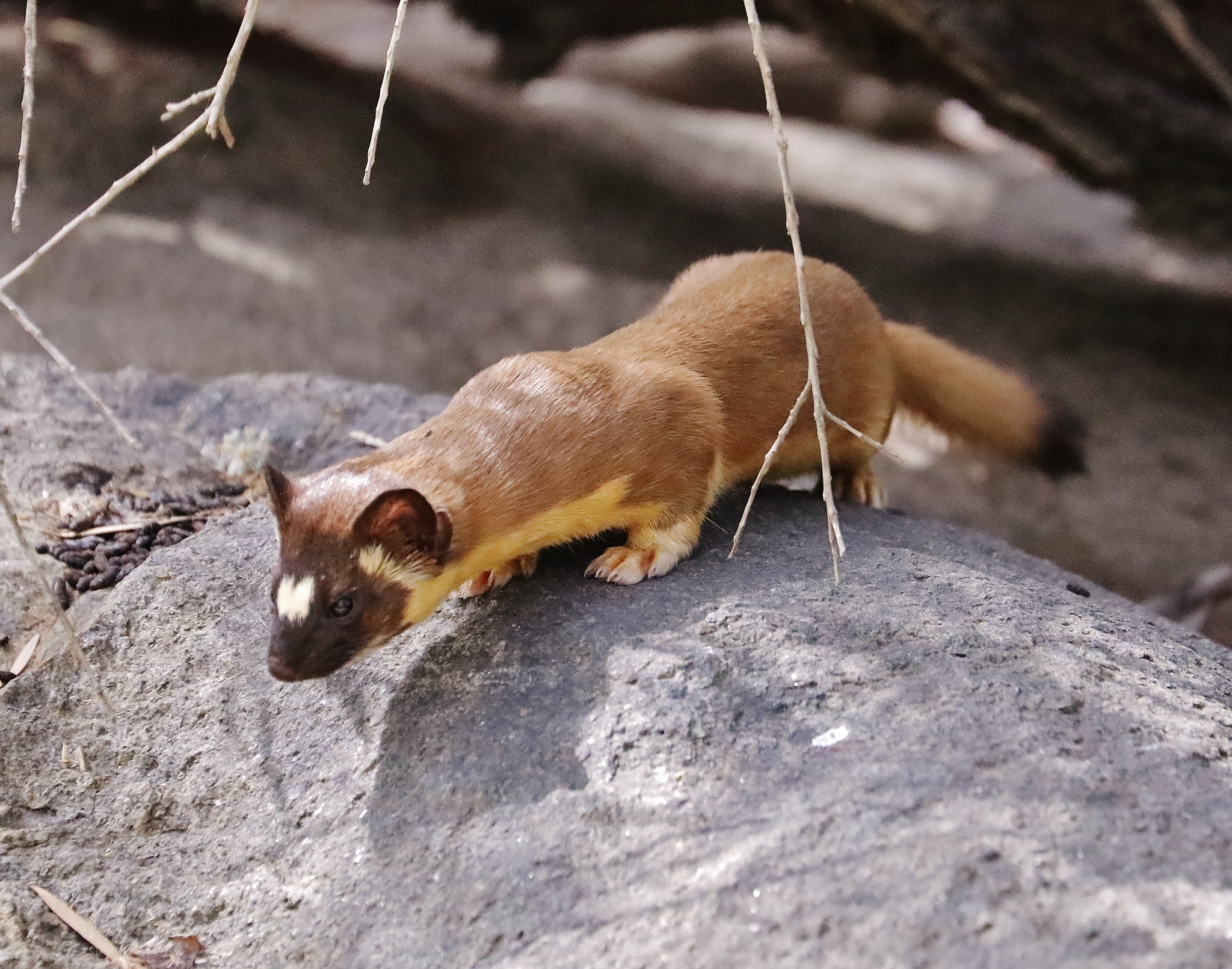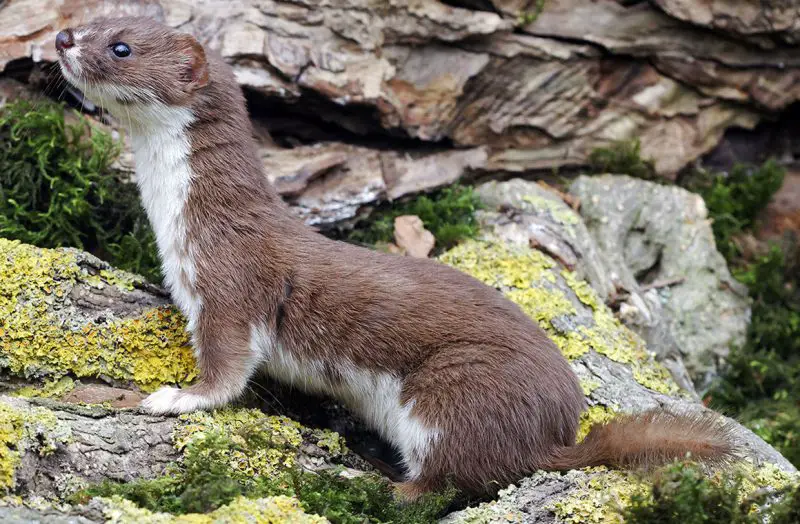Weasels are among the most elusive and fascinating predators in Wisconsin’s wild landscapes. Despite their small size, they are fierce, fast, and highly skilled hunters. From farmlands and forests to grasslands and wetlands, these mammals silently patrol the underbrush, playing a key role in controlling rodent populations.
Wisconsin is home to three native species of weasels: the long-tailed weasel, the short-tailed weasel (also known as the ermine), and the least weasel. While they share similar habits and body shapes, subtle differences in size, tail length, and coloration—especially in winter—can help you tell them apart.
This guide will walk you through detailed identification tips, behavior traits, and seasonal changes of each weasel species found in Wisconsin. With helpful descriptions and pictures, you’ll be able to spot these secretive mammals in the wild—or at least recognize their presence.
Common Weasels Found in Wisconsin
Long-tailed Weasel (Mustela frenata)

The long-tailed weasel is the largest of the three weasel species found in Wisconsin and is distinguished by its elongated body, short legs, and notably long tail, which often measures nearly half its total body length. In summer, its fur is rich brown on the back with a creamy white or yellowish underside, while the tail ends in a distinct black tip. During the colder months, especially in northern Wisconsin, the weasel’s coat transforms to a snowy white to blend in with its surroundings, but the black tail tip remains, serving as a key identification marker throughout the year.
This species typically measures between 11 to 17 inches in length, with the tail making up 4 to 6 inches. Males are significantly larger than females. Long-tailed weasels are sleek and agile predators with excellent vision, hearing, and a remarkable sense of smell. Their slender bodies enable them to chase prey into burrows and other tight spaces. They are solitary animals, fiercely territorial, and mostly nocturnal, although they can also be active during the day, especially during peak hunting hours at dawn and dusk.
Long-tailed weasels feed primarily on small mammals such as mice, voles, and rabbits, but they are opportunistic hunters and will also eat birds, reptiles, amphibians, and insects when available. They kill their prey with a powerful bite to the back of the head or neck. This species plays an important role in natural rodent control and is often found in farmland, grasslands, woodlots, and along watercourses. They prefer habitats with dense vegetation and ground cover for stalking prey and hiding from predators.
In Wisconsin, the long-tailed weasel is found throughout the state, though sightings are more frequent in southern and central regions. Breeding occurs in late summer, but implantation of the fertilized egg is delayed until spring, resulting in young being born in late April or May. Litters usually contain four to eight kits, which are raised in dens lined with fur and feathers. The young are independent by late summer, setting out to establish territories of their own. These adaptable predators thrive in both rural and suburban environments, often going unnoticed due to their elusive behavior.
Short-tailed Weasel / Ermine (Mustela erminea or Mustela richardsonii)

The short-tailed weasel, also known as the ermine when in its white winter coat, is slightly smaller than its long-tailed cousin but is the most commonly encountered weasel species in Wisconsin. Its summer fur is dark brown on the back with a white underbelly, and like the long-tailed weasel, it turns completely white in the winter except for its black-tipped tail. The tail is shorter in proportion to the body compared to the long-tailed weasel, generally making up less than 40% of the animal’s length.
Adults typically measure between 9 and 13 inches long, including a 2 to 4 inch tail. Despite its small size, the short-tailed weasel is an incredibly fierce and efficient predator. It is lightning-fast, capable of taking down prey larger than itself. Short-tailed weasels are known for their boundless energy and curious nature, often seen darting through snowbanks or underbrush in search of food. They are solitary and territorial, marking their domain with scent glands and vocalizations to deter rivals.
The diet of the short-tailed weasel mirrors that of the long-tailed weasel, consisting mainly of rodents such as voles, mice, and shrews. They also prey on birds, eggs, frogs, and insects. With a high metabolic rate, they need to eat frequently and are constantly on the move. They kill quickly with a precise bite to the base of the skull. Their slender, sinuous bodies allow them to enter burrows and follow prey into tunnels, making them highly effective hunters in forested and field environments alike.
This species is widespread across Wisconsin, from dense woodlands in the north to open prairies and agricultural areas in the south. Breeding typically occurs in summer, with a delay in implantation until early spring. The young, born in late April or May, number around four to nine per litter. Dens are often made in abandoned burrows, hollow logs, or beneath brush piles. Short-tailed weasels are active throughout the year, including winter, and their seasonal color change provides critical camouflage against snow. Their adaptability and hunting prowess make them a valuable part of Wisconsin’s native ecosystem.
Least Weasel (Mustela nivalis)

The least weasel is the smallest carnivorous mammal in Wisconsin and one of the smallest in the world. Adults range from just 6 to 8 inches in length, including a tail of barely 0.75 to 1.25 inches. Unlike the other two weasel species in the state, the least weasel lacks a black tip on its tail—a helpful trait for identification. It has a brown back and white underparts during the summer, and like its relatives, it molts into a white winter coat for seasonal camouflage, although its tail remains entirely white year-round.
Despite its tiny size, the least weasel is a ferocious and agile predator, capable of tackling prey nearly its own size or even larger. It is quick, flexible, and fearless, with a metabolism so high that it must hunt almost constantly to stay alive. Least weasels are solitary creatures and extremely elusive, often going unseen due to their size and secretive behavior. They are diurnal or crepuscular, active mostly during the day or at twilight, and spend much of their time hunting in thick grasses or brush.
Their diet consists almost exclusively of small mammals such as mice and voles, but they will occasionally eat small birds or insects when necessary. Least weasels prefer habitats with abundant ground cover, including fields, grasslands, marshes, and edges of forests. Unlike their larger cousins, they tend to avoid deep woods. In Wisconsin, they are more frequently found in the southern part of the state, although confirmed sightings remain relatively rare due to their size and shy nature.
Breeding for least weasels occurs in spring or early summer, and females can give birth to multiple litters in a season, each consisting of four to six young. Their nests are built in grassy hollows, rodent burrows, or brush piles and are lined with fur from their prey. Kits develop rapidly and begin hunting on their own at just a few weeks of age. Despite their short lifespan—often only a year or two—least weasels play a critical role in controlling rodent populations in Wisconsin’s grassland ecosystems. Their diminutive size and fierce nature make them one of the state’s most remarkable and underappreciated mammals.
FAQs About Weasels in Wisconsin
What types of weasels live in Wisconsin?
Wisconsin is home to three native species of weasels: the long-tailed weasel (Mustela frenata), the short-tailed weasel or ermine (Mustela erminea or M. richardsonii), and the least weasel (Mustela nivalis). Each species varies in size, tail length, and seasonal coat changes, but all are skilled predators that help control rodent populations.
How can you tell the difference between Wisconsin’s weasel species?
The most reliable way to differentiate between the species is by size and tail characteristics. The long-tailed weasel is the largest and has the longest tail with a black tip. The short-tailed weasel is slightly smaller and also has a black-tipped tail, but it’s shorter in proportion. The least weasel is the smallest and has a short white tail with no black tip, making it easy to identify in both summer and winter.
Do all weasels in Wisconsin turn white in the winter?
Yes, all three species of weasels in Wisconsin undergo a seasonal color change, turning from brown in summer to white in winter. This change helps them camouflage in snowy conditions. However, the black tail tip remains on both the long-tailed and short-tailed weasels, while the least weasel stays completely white, which is a key winter identification feature.
Where can I see weasels in Wisconsin?
Weasels are distributed across Wisconsin, but sightings are rare due to their small size and elusive nature. Short-tailed weasels are the most widespread and commonly found throughout the state in forests, fields, and wetlands. Long-tailed weasels are also widely distributed, especially in southern and central regions. Least weasels are harder to spot and are more commonly found in the southern part of the state, particularly in grasslands and open fields.
Are weasels dangerous to humans or pets?
Weasels are not dangerous to humans and generally avoid contact. While they are aggressive hunters when it comes to small prey, they are not a threat to people or larger animals. However, in rare cases, weasels may attempt to enter chicken coops or bird nests in search of food. It’s best to secure small livestock or poultry enclosures if you live in areas where weasels are active.
What do weasels eat in Wisconsin?
Weasels in Wisconsin are carnivorous and mainly feed on small mammals like mice, voles, and shrews. They also eat birds, bird eggs, insects, frogs, and even small reptiles when available. Their diet varies with the season and habitat, but all three species are excellent rodent controllers and play an important ecological role.
When do weasels breed and raise their young?
Weasels typically breed in late spring or summer. Both the long-tailed and short-tailed weasels exhibit delayed implantation, meaning fertilized eggs do not begin developing until months after mating. Young are usually born in late April or May, and each litter can contain 4 to 9 kits, depending on the species. Kits are raised in dens and become independent within two to three months.
Are weasels active in winter?
Yes, weasels remain active throughout the winter and do not hibernate. Their white winter coats help them blend into snowy environments while they hunt for prey beneath the snowpack. Their small size and high metabolism mean they need to eat frequently, so they are often on the move—even during the coldest months.






